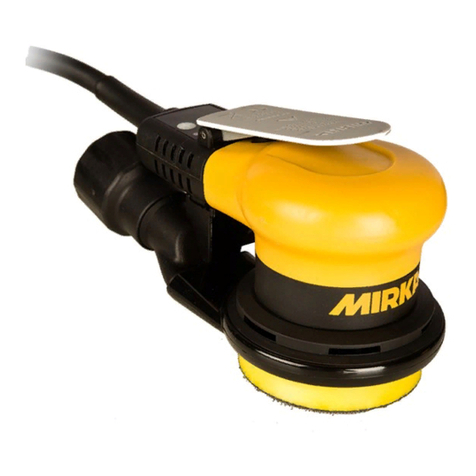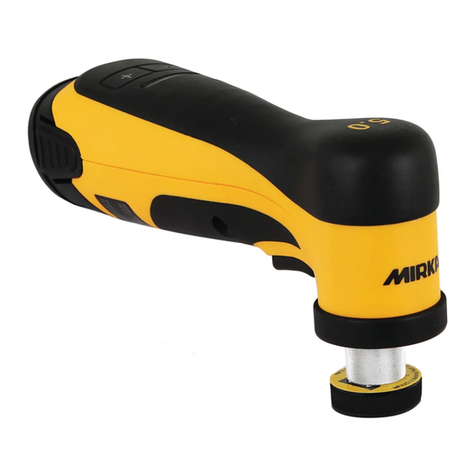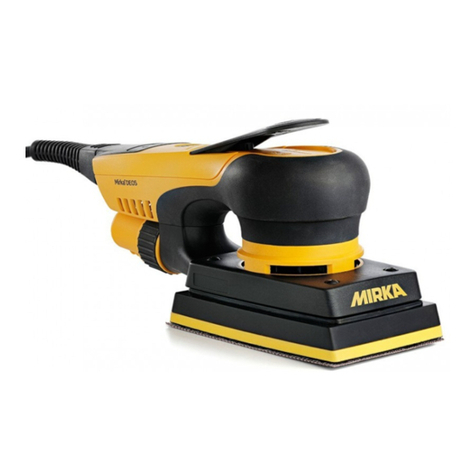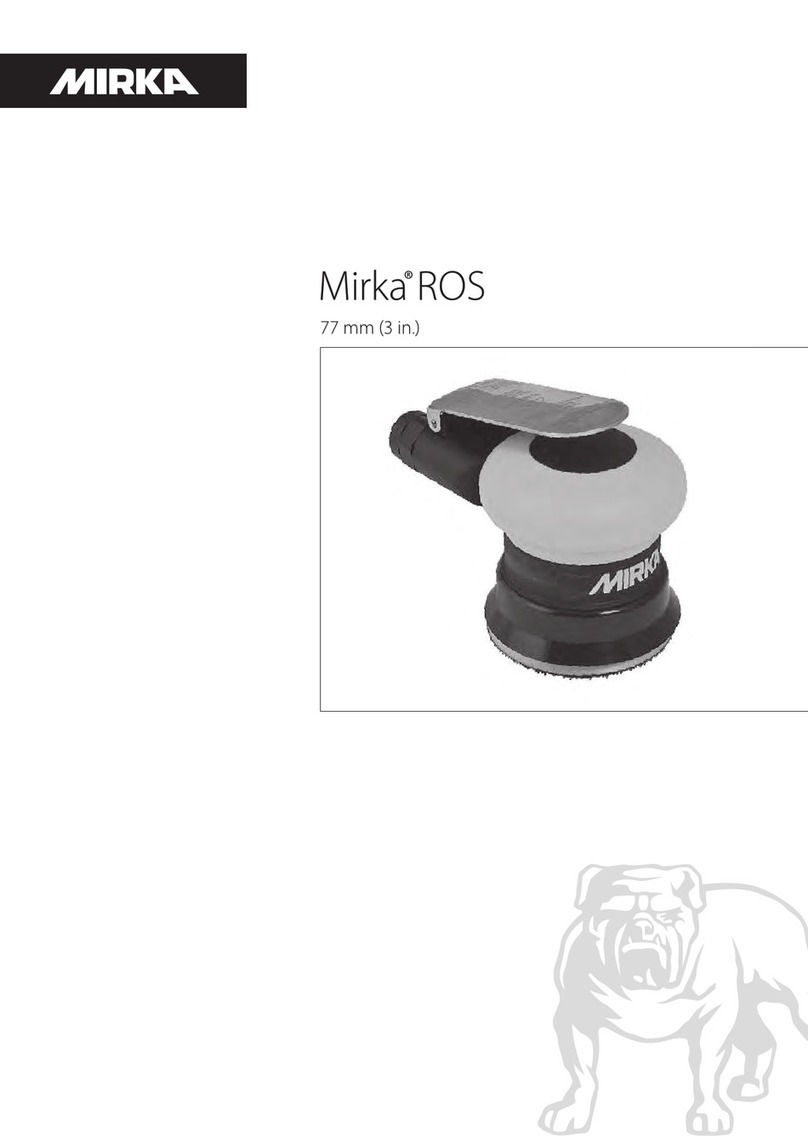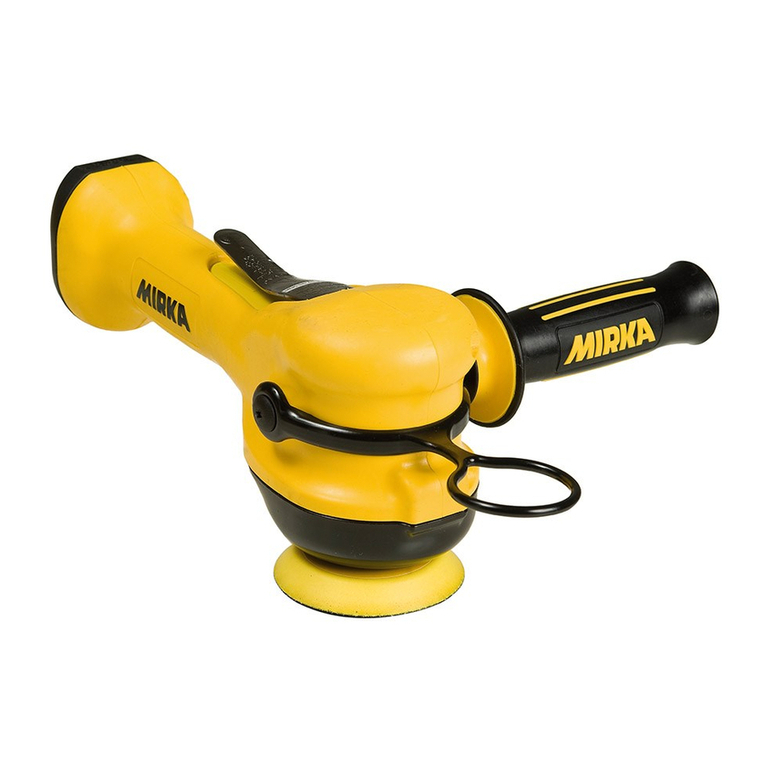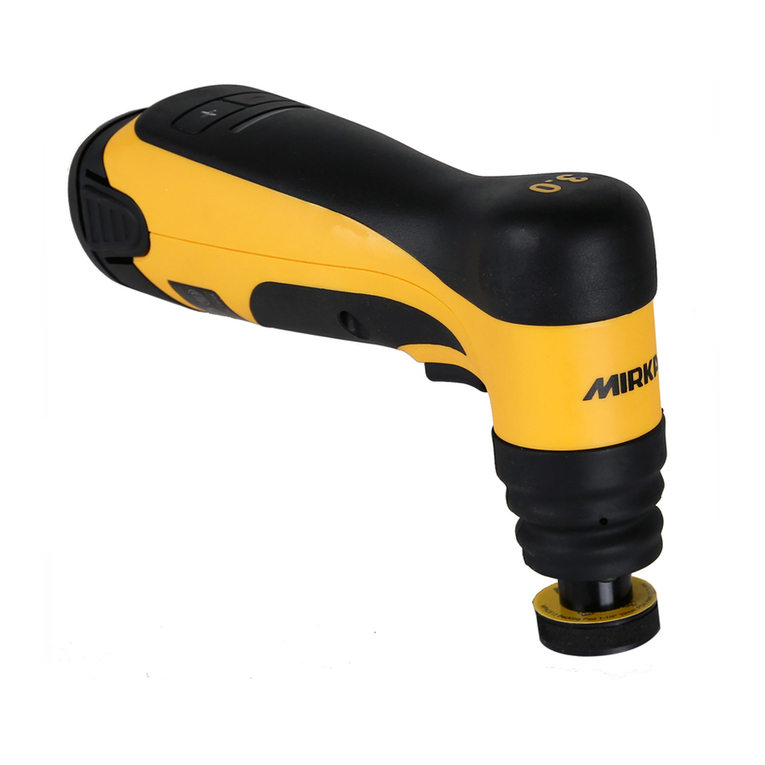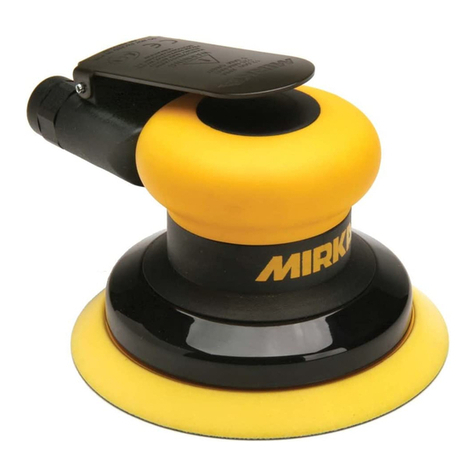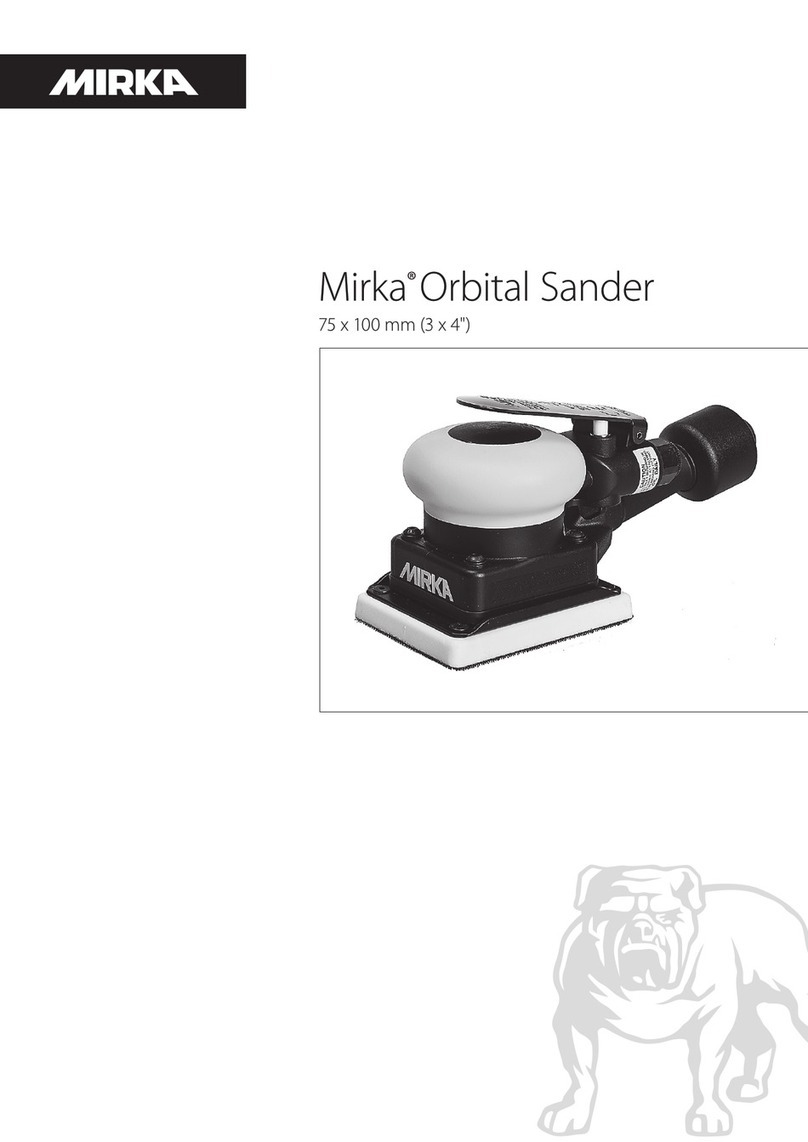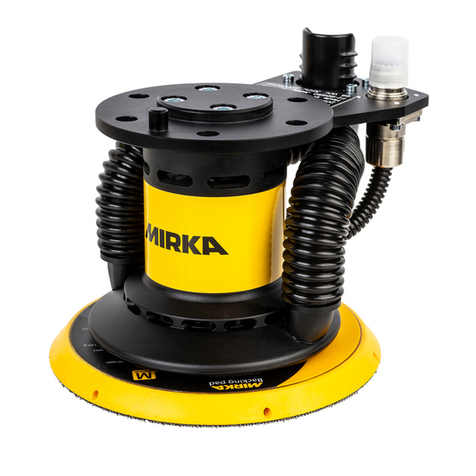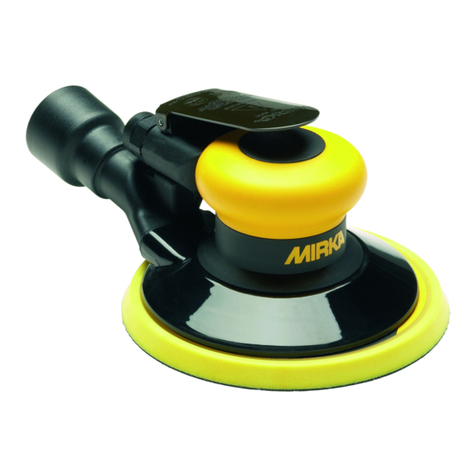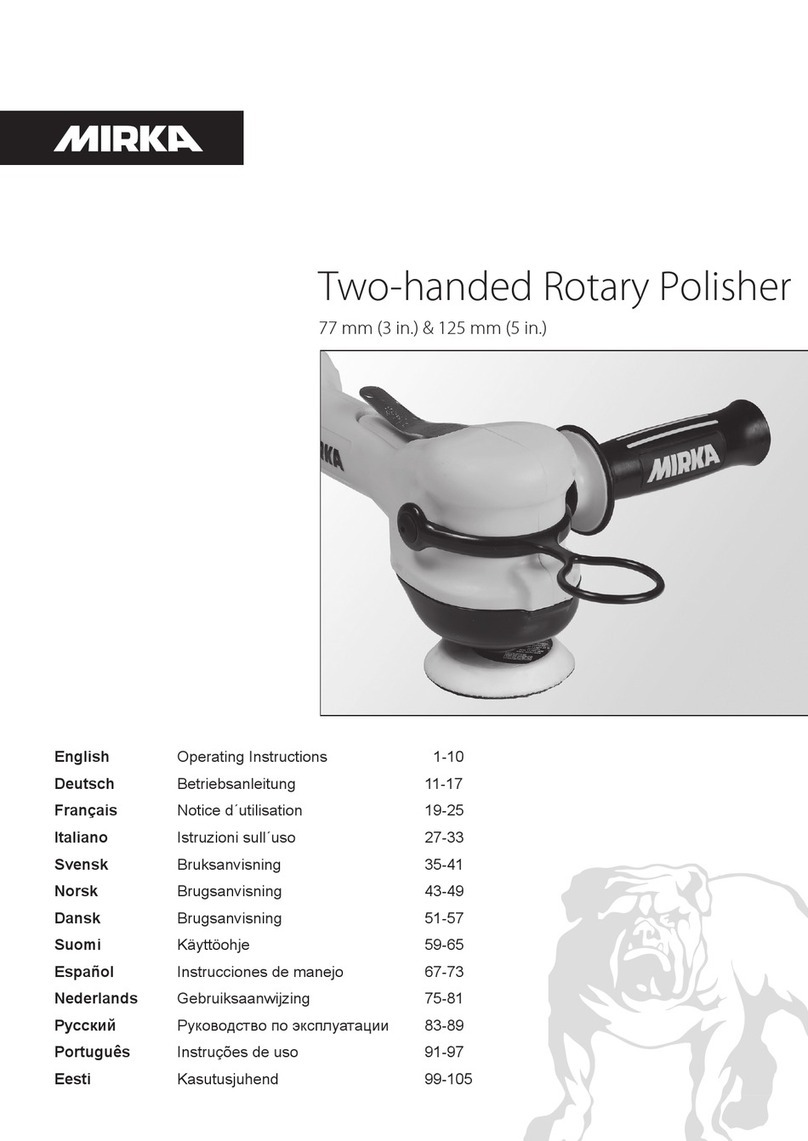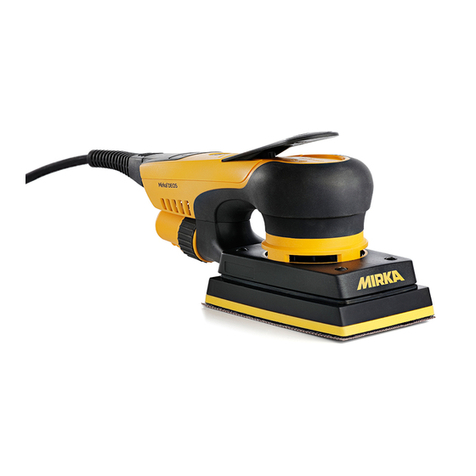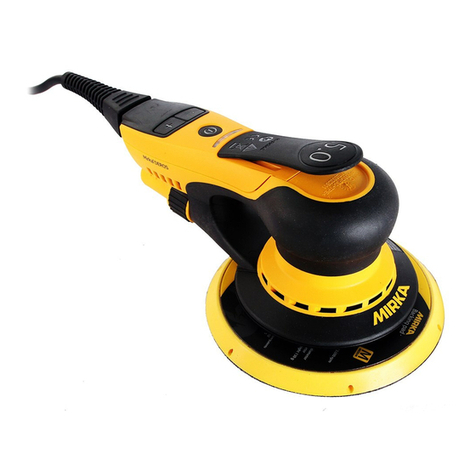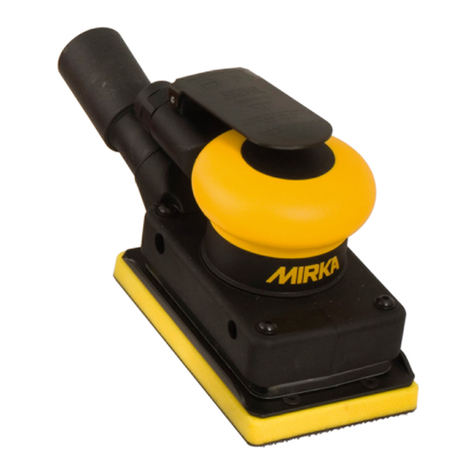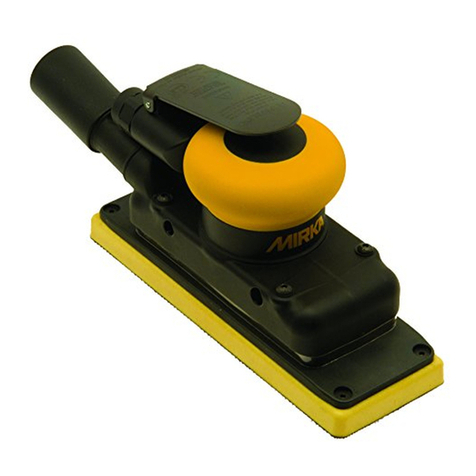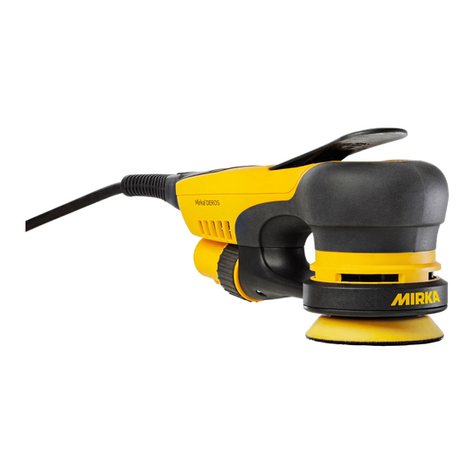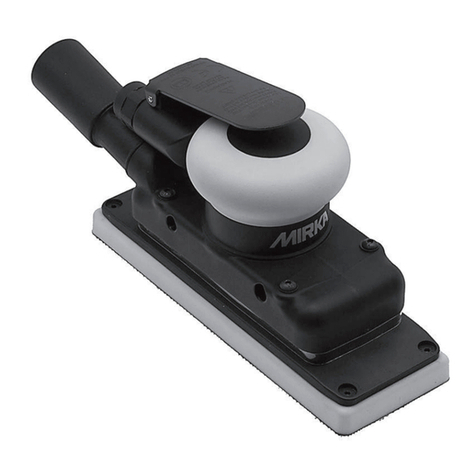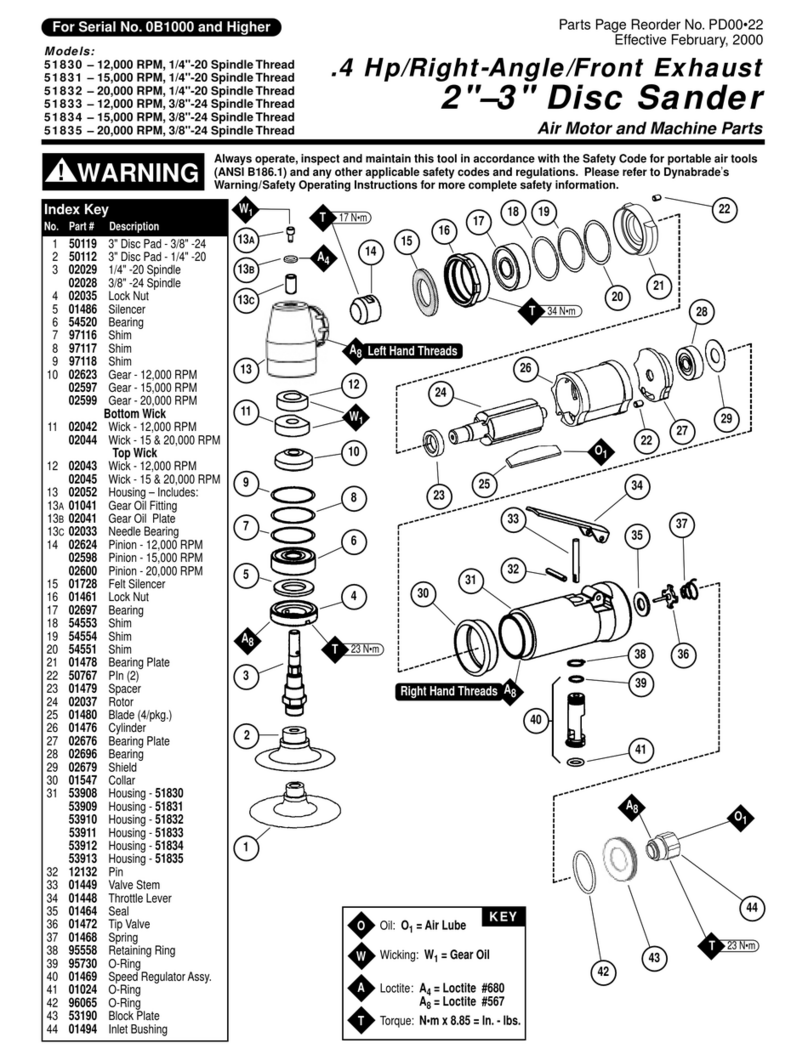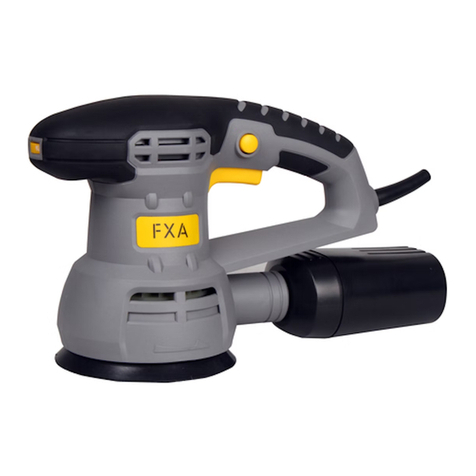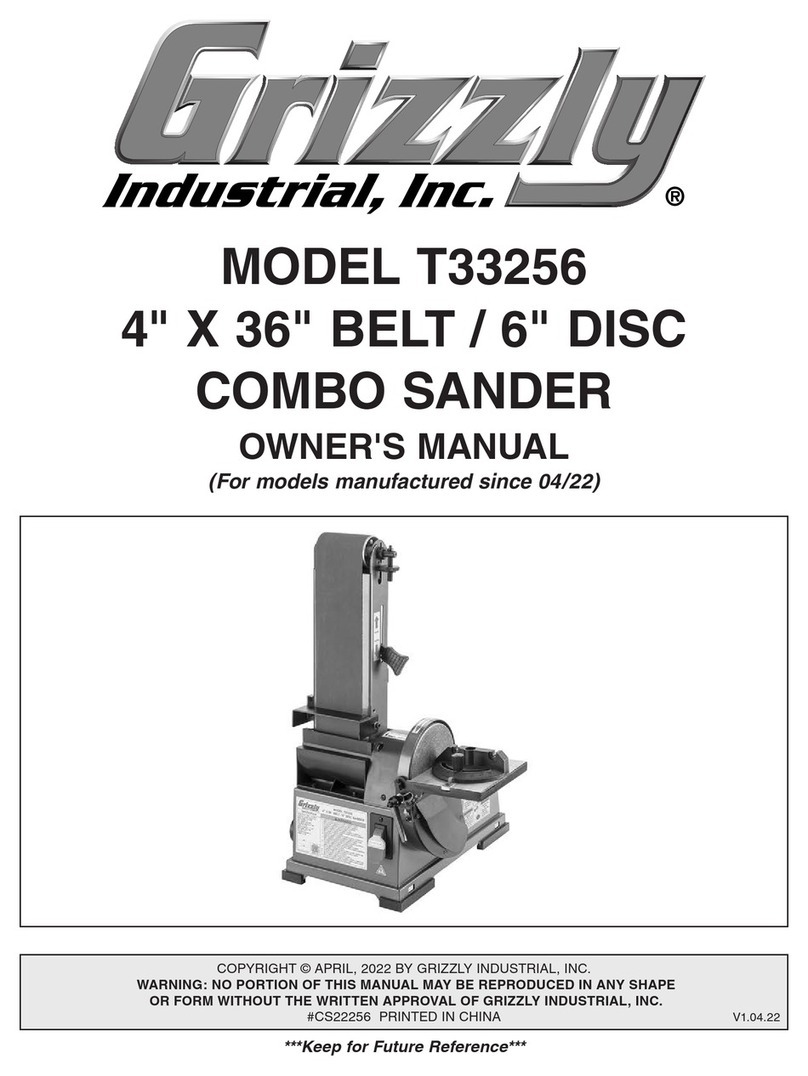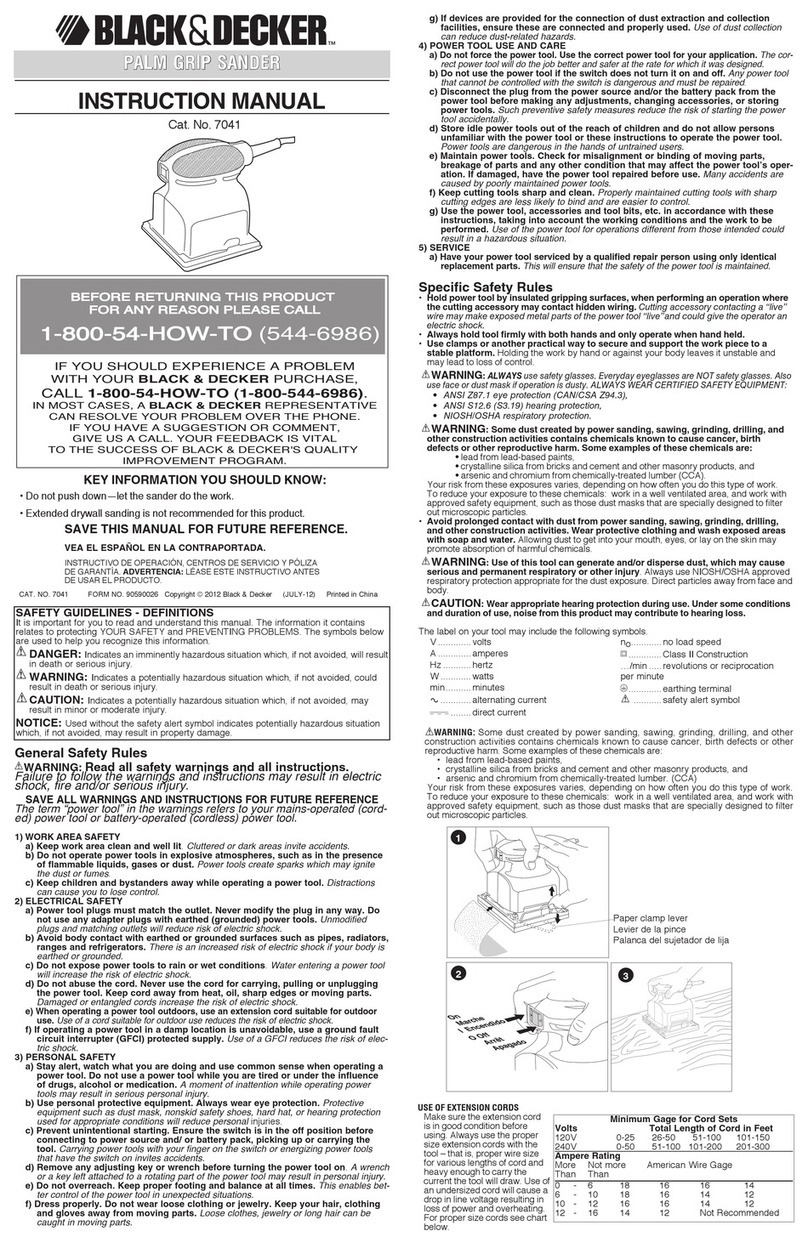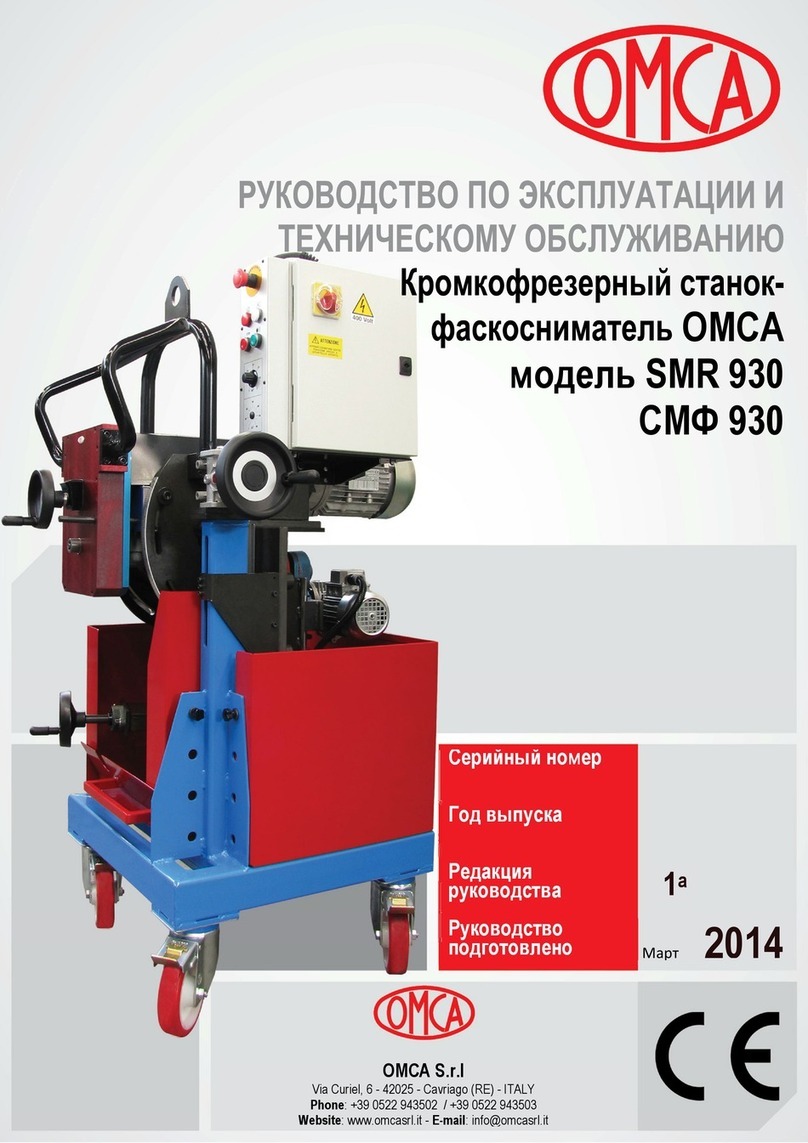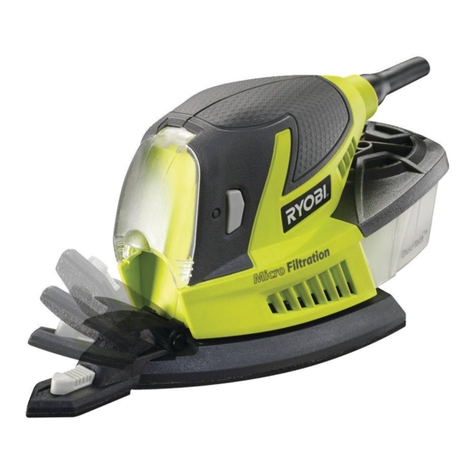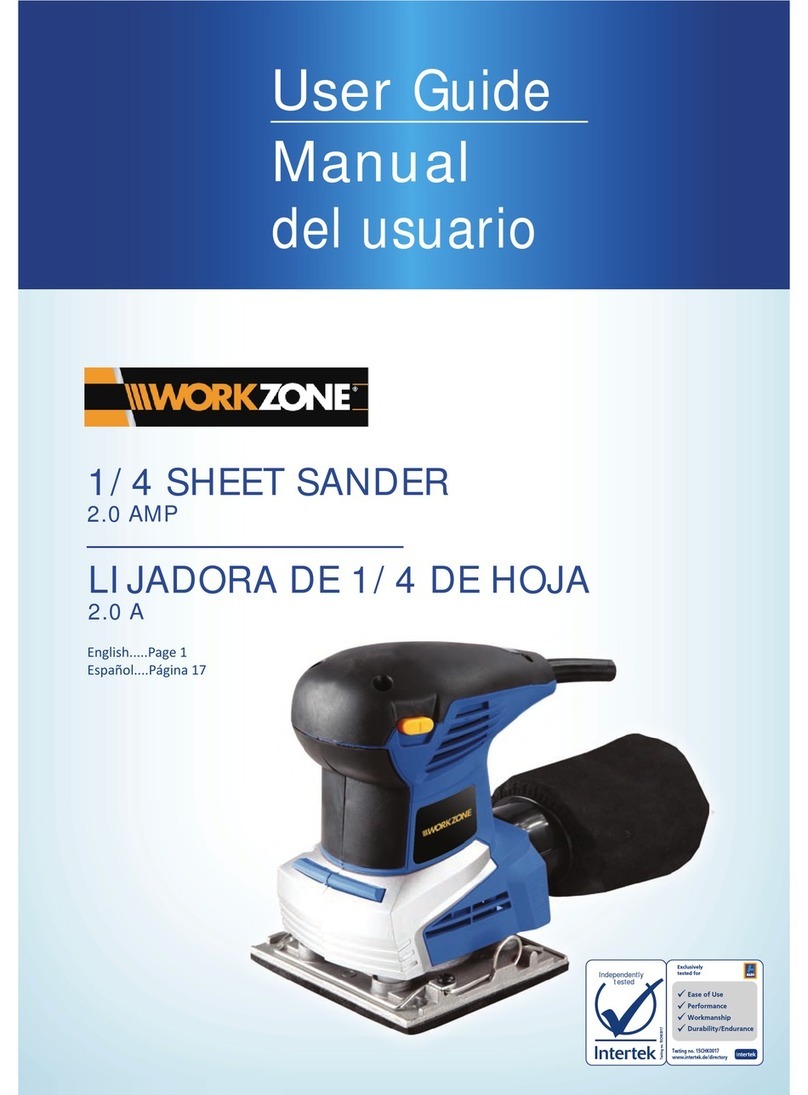
8
MIRKA 12,000 RPM
77 mm (3 in.)
RANDOM ORBITAL SANDERS
SERVICE INSTRUCTIONS
NOTICE: To receive any expressed or implied warranty, tool must be repaired by an authorized Mirka Service Center. The following
general service instructions provided are for use after completion of the warranty period.
DISASSEMBLY INSTRUCTIONS
Changing Grips:
1. The(27)Griphastwo“tabs”thatwraparoundthebodyofthe
sander under the inlet and exhaust. Use a small screwdriver
topickoutoneofthe“tabs”oftheGrip,andthencontinueto
go underneath the Grip with the screwdriver and pry the Grip
off the sander. To install a new Grip, hold the Grip by the tabs
making them face outward, align the Grip and slide it under
the (25) Throttle Lever then press the Grip down until it seats
ontothetopofthesander.Makesurethetwo“tabs”seat
under the inlet and exhaust.
Motor Disassembly:
1. Lightly secure the tool in a vise using the (MPA0026) T-7 Ser-
vice Collar or padded jaws. Use a (36) 17 mm Pad Wrench
to secure the (24) Spindle and spin the (37) Pad counter
clock-wise off the spindle.
2. Remove the (12) Lock Ring with the (MPA0025) T-6 Motor
Lock Ring Wrench/Spindle Puller Tool. The motor assembly
cannowbeliftedoutofthe(29)Housing.Removethe(11)
O-Ring from the Lock Ring.
3. Secure the motor assembly by clamping the (13) Shaft
Balancer in a padded jaw vise and remove the (1) Retaining
Ring from the end of the Shaft Balancer and the (5) O-Ring
from the (4) Cylinder.
4. Remove the (3) Rear Endplate. This may require supporting
the Rear Endplate with a (MPA0416) Bearing Separator. Use
a light press force to push the (13) Shaft Balancer through
the Bearing. Then remove the (4) Cylinder, (7) Vanes and
the (6) Rotor. Remove the (8) Key from the Shaft Balancer.
Supportthe(9)FrontEndplatewithaBearingSeparatorand
use a light press force to push the Shaft Balancer through the
bearing. It may be necessary to remove the (10) Bearing with
a Bearing Separator if it came out of the Front Endplate and
stuck to the shaft of the Shaft Balancer.
5. Remove the Bearing(s) from the Endplates by using the
(MPA0036) T-8 Endplate Bearing Removal Tool to press out
the Bearings.
Shaft Balancer and Spindle Disassembly:
1. Grip the shaft end of the (13) Shaft Balancer in a padded
vise. With a thin screwdriver pick out the slotted end of the
(23) Retaining Ring and peel out.
2. Screw the female end of the (MPA0271) T-11 5/16-24
to 1/4-20 Adapter into the male end of the (MPA0025)
Service Wrench. Screw the Service Wrench assembly into
the (24) Spindle Assembly until hand tight. Apply a gentle
heat from a propane torch or hot air gun to the large end
of the (13) Shaft Balancer until it is about 100° C (212°
F) to soften the adhesive. Do not over heat. Remove
the Spindle Assembly by using the Slider to give sharp
outward blows to the Spindle. Allow the parts to cool so
they are safe to handle.
3. Remove the (17) Retaining Ring from the (24) Spindle As-
sembly. Use a small Bearing Separator to remove the (20)
Bearing, (21) Shim, (22) Bearing, (23) Shim and the (24)
Washer from the Spindle Assembly.
4. The AirSHIELD™ components are held in place by the
lightpresstofthe(16)Retainer.Thesecomponentscan
be damaged during removal and may need to be replaced
if removed. To remove the Retainer, use an O-ring pick or
a #8 sheet metal screw to grip and pull out the retainer.
Remove the (15) Valve and (14) Filter from the bore in the
(13) Shaft Balancer. If the Retainer and Valve were not
damaged, they can be reused. However, the Filter should
be replaced on re-assembly.
Housing Disassembly:
1. For Non-Vacuum (NV) and Central Vacuum (CV) machines
follow the steps outlined in Section I below. For Self Gener-
ated Vacuum (SGV) machines follow the steps outlined in
Section III.
I. This section is for CV and NV machines:
A) Unscrewthe(40)MuferHousingandthe(38)Mufer.
RemovetheMuferfromtheMuferHousingandremovethe
(39)MuferinsertfrominsidetheMuferHousing.ForNV
machines move onto B. For CV machines move onto Section
II.
B) Remove the (34) 77 mm (3 in.) Non-Vacuum Shroud.
II. For CV Exhaust machines:
A) Removethe(59)Screw,(58)Washerand(57)Nut.
B) Removethe(55)Ø19mm(¾in.)SuperVAC™CVSwivel
Exhaust Assembly (Standard) or the (56) SuperVAC ™ CV Ø
28 mm (1 in.) Swivel Exhaust Assembly (Optional) from the
(35) 77 mm (3 in.) SuperVAC™ Shroud.
C) Remove the (35) 77 mm (3 in.) SuperVAC™ Shroud from the
(29)Housing.
III. For SGV Exhaust machines:
A) Unscrewthe(46)SGVRetainerwithan(MPA0849)8mm
Hex Key.
B) Removethe(47)Ø19mm(3/4in.)HoseSGVSwivel
ExhaustAssembly(Optional)or(49)Ø28mm(1in.)Hose
SGV Swivel Exhaust Assembly (Standard) from the (54)
SuperVAC™ Adapter.
C) PulltheSGVRetaineroutoftheboreofthe(47or49)Swivel
Exhaust Assembly and remove the two (45) O-Rings.
D) Remove the (35) 77 mm (3 in.) SuperVAC™ Shroud from the
(29)Housing.Moveontostep2.
2. Place the (32) Speed Control to the midway position and
remove the (33) Retaining Ring. Note: If the machine is one
of the vacuum models, the vacuum exhaust assembly must
be removed (see section 1 above for removal) before the Re-
taining Ring can be removed with lock ring pliers. The Speed
Control will now pull straight out. Remove the (31) O-Ring.
3. Unscrewthe(43)InletBushingAssemblyfromthe(29)Hous-
ing. Remove the (42) Spring, (41) Valve, (40) Seat, (35) Valve
Stem and the O-Ring.
4. Pressoutthe(26)SpringPinfromthe(29)Housingandre-
move the (25) Lever then press out the (28) Sleeve in either
direction.
ASSEMBLY INSTRUCTIONS
NOTE: All assembly must be done with clean dry parts and all
bearings are to be pressed in place by the correct tools and
procedures as outlined by the bearing manufacturers.
Housing Assembly:
1. Pressthe(28)Sleeveintothe(29)Housingushwiththetop
from the (25) Throttle Lever side. Install Throttle Lever into
Housing with (26) Spring Pin.
2. Lightly grease the (31) O-Ring and place it on the (32) Speed
Control. Install the (30) Valve Stem and O-Ring (cleaned and
lightlygreased)andinserttheSpeedControlinto(29)Hous-
ing in the midway position. Install (33) Retaining Ring. Cau-
tion: Make sure the Retaining Ring is completely snapped
into the groove in the Housing.
3. Install the (41) Seat, (42) Valve and the (43) Valve Spring.
Coat the threads of the (44) Bushing Assembly with 1 or 2
drops of Loctite™ 222 or equivalent non-permanent pipe
thread sealant. Screw the Bushing Assembly into the inlet
